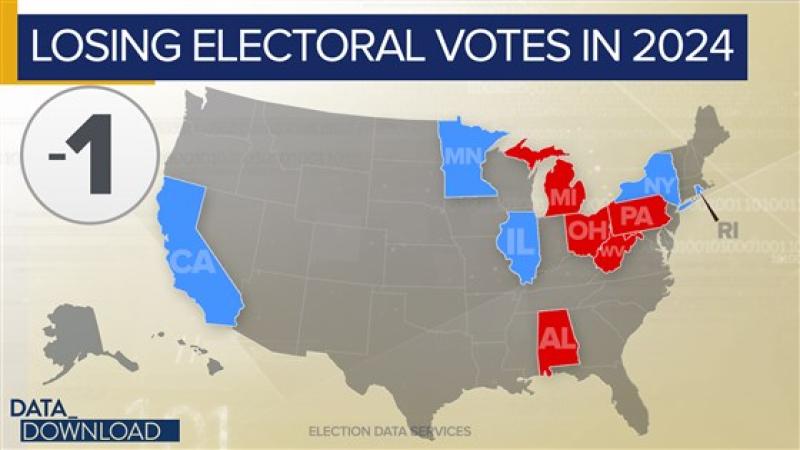New electoral map comes into focus ahead of 2020 census
By: Dante Chinni (NBC News)


The seeded article was published last January but explains the Democrat's renewed interest in eliminating the electoral college. The electoral map is changing. The population of traditional red states is growing faster than the population of traditional blue states.
The shifts in population density suggest that the Democratic Party will become less competitive in Presidential elections. Democrats are going to need to expand their efforts in traditional red states. That's why there was so much effort to flip states during the 2020 election.
The actual results of the 2020 election clearly show that Democrats are at a bigger disadvantage than they thought. Donald Trump, flawed candidate that he was, retained (and in some cases expanded) support in states that will be gaining electoral votes. If a flawed Republican candidate, like Trump, can hold states in the Republican camp then Democratic efforts to flip those states becomes an even bigger challenge.
Donald Trump has shown the Republican Party how to retain and expand its base. Donald Trump's performance in 2020 will force the Democratic Party to change its politics simply because of the coming electoral disadvantage. The shifts in population density suggests the United States is becoming less coastal; the population in the heartland is growing faster than the population on the coasts.
Democrats best hope is to eliminate the electoral college. Unfortunately the Democrats failure to expand into traditional red states during the 2020 election makes eliminating the electoral college far less likely. All the arguments to eliminate the electoral college is much ado about nothing.
Unless the Democratic Party changes, the country will likely become more Republican.

The coming year is going to be about more than choosing a new president; it's going to be about creating a new Electoral College map. The 2020 Census will lead to a new congressional apportionment that will lead to a new path to the 270 electoral votes for winning the White House, beginning in 2024.
But data analysts already have a pretty good idea of what the new map may look like. And one projected map released last week shows some major moves, most of which might favor Republicans, at least in the short term.
The map from Election Data Services finds that 10 different states are likely to lose one House seat, and therefore one electoral vote, in the next congressional reapportionment. Looking at the 2016 election results, those losses are evenly spread politically among blue and red states.
On the red side of the ledger, Alabama, Michigan, Ohio, Pennsylvania and West Virginia all look ready to lose an electoral vote. On the blue side, the victims are California, Illinois, Minnesota, New York and Rhode Island. That's minus five for the Republican 2016 map and minus five for the Democrats.
There are some surprises on that list. For instance, California is slated to lose a seat for the first time ever and that's despite gaining more than 2 million in population since 2010. That's a lot of people, but it looks like it's not going to be enough to hold on to the state's current allotment of 53 House seats in the next accounting.
If those are the losses, which states are gaining? There are five states that are slated to gain one congressional seat and one vote. And Republicans see a gain here.
Arizona, Montana and North Carolina all look like they are going to pick up one seat and they all voted for President Donald Trump in 2016. On the Democratic side, Colorado and Oregon, which voted for Hillary Clinton, are in line to add a seat.
Add all those pluses and minuses up and you get a net gain of one for the GOP in the Electoral College.
But the Republicans get bigger wins when you factor in two states that are supposed to see larger additions to their congressional delegations: Texas and Florida.
Florida, the perpetual presidential battleground, is estimated to gain two House seats in the next congressional reapportionment. That would bring its total electoral vote count to 31, moving it out of a tie with New York to become the third-largest presidential prize.
And Texas, which has long been a safe Republican state, looks like it will pick up three congressional seats, upping its electoral vote count to 41.
Taken together, the changes on the electoral map would equal an even bigger win for a future GOP nominee who could follow Donald Trump's 2016 electoral path to victory. That Republican would capture 309 electoral votes, 80 more votes than the Democrats 229.
But before Republicans start popping open champagne, there are a few other factors to consider beyond the closeness of the vote in several key states in 2016.
All the numbers here are based on changes: states growing larger or smaller because of migration, birth rates and death rates. And those changes aren't suddenly going to stop. These places are still changing.
Consider Texas, the fastest grower on the list. There are signs that as the state adds population, it is becoming more politically competitive. In 2016, Trump won Texas by less than 10 percentage points. That was low compared to Mitt Romney's nearly 16-point win in the 2012 presidential race. And in 2018, Republican Sen. Ted Cruz won re-election in the state by only about 2.5 points.
There are big demographic changes afoot in the state. Since 2010, its white, non-Hispanic population has declined by four percentage points. Meanwhile, the percentage of white, non-Hispanic voters with a college degree has climbed by five points.
Those demographic trends both favor Democrats. They are not likely to reverse themselves and they could have big impacts in the years ahead.
For years, political observers have wondered what politics would look like if deep-blue California, the nation's most populous state by far, became a battleground. California has 55 electoral votes.
In the forecasted post-2020 world, Texas and Florida together would have 72 electoral votes. Imagine a quarter of the electoral votes needed to win the White House in just two hotly-contested states. That's not just a different electoral map, it's a different political world.






Sorry, liberals, the electoral map will force the Democratic Party to shift to the right to remain competitive.
Where do you think those blue state liberals are moving to? They're going to places like Houston, San Antonio, Philadelphia, and Atlanta which is why Texas is becoming increasingly purple and Georgia just voted blue in a Presidential election for the first time in 28 years.
Then explain the 2020 election results. The population has already shifted; the electoral map hasn't been adjusted yet. The 2020 election should provide some clues about future elections after the electoral map has been adjusted.
Why would you think that blue state liberals are moving to red states? Not everyone living in blue states have been liberals or Democrats. The 2020 election results show that, too.
Cities have a way of increasing Democratic support in a state. It would be one thing if the population were static and we were deurbanizing, but that isn’t case. Population is always increasing. As more people move to red states, cities will grow, and those states will become more blue.
That doesn't explain the 2020 election results. The population has already moved; the electoral map hasn't been adjusted yet.
Doesn’t it though? Look at a place like Arizona. That state used to be reliably red, but as more people move there and inhabit the cities, it is creeping into the blue. That has been the situation with a lot of states in the West - Colorado, Oregon, Washington, Nevada, California. Once upon a time, these were all Republican states, but they have become more democratic as population has grown and cities along with it. Eventually, cities like Austin and Houston will become big enough that Texas will be Democratic.
According to projections, Arizona will gain one electoral vote. Texas will gain 3, Florida will gain 2.
New York, Pennsylvania, Ohio, Michigan, Illinois, Minnesota, and California are each projected to lose one electoral vote and one House district. And it is possible some of those states will lose more than one. The Democrat's blue wall is going to lose 7 (or more) electoral votes and House seats.
Based on the electoral shift projections, Trump would have won five more electoral votes and Biden would have lost five electoral votes had the electoral map been adjusted before the 2020 election. The population has already moved. Adjusting the electoral map may shift which states become a battleground state.
Not seeing the big wave. Projections...
In 2020, it would have cost Biden 4 EVs and in 2016, Trump would have gotten 5 less. There is a reason some states are called toss-ups.
As for the congressional status. In traditional blue states that are losing a seat, with at least one republican congress person... that will be one less republican congress person. In traditional red states with that are losing a seat, with at least one democrat congress person... that will be one less democratic congress person.
In states gaining seats... every effort will be made to add seats by redistributing districts in a manner to weaken or dilute the opposing party's perceived advantage. That is how gerrymandering works.